1st May 2019
Airports in the UK (and to a wider extent in Europe) are facing unique challenges in the current environment as annual passenger and aircraft movements continue to increase. At a time when ANSPs and airports are faced with implementing (often mandatory) rules from the EC and a plethora of solutions emerging from SESAR, how can novel modelling techniques quickly identify the benefits of operational improvements and how can they help develop optimal deployment roadmaps, driving procurement of the most cost beneficial systems?
Unique constraints on capacity
It is important to understand that before any benefits to capacity can be realised, we first need to identify the key constraints that affect the current capacity at the airport. These key constraints will typically vary based on the size of the airport and hence will drive different requirements for increasing operational performance/capacity in the airport masterplan. Key constraints in capacity can be found at any stage in operations at an airport – from within the terminal building through to restrictions in the surrounding airspace. The dependency between all these factors becomes increasingly sensitive with airport size.
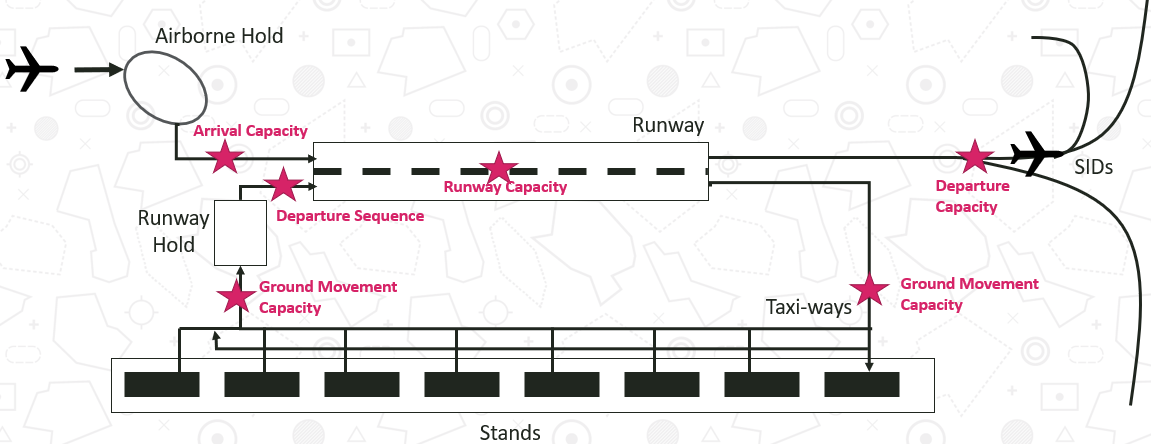
An example of regions where key capacity constraints typically occur during airside operations.
Key constraints – Regional to Medium sized airports
Often, at regional to medium sized airports, the runway is not the primary constraint on capacity. It is instead driven by pressures elsewhere in the system, such as facilities within the terminal building (e.g. security), constraints on the taxiway system or available aircraft stands. It is these unique pressures that need to be captured and addressed within a capacity assessment / airport masterplan. Another key challenge faced by growing airports are the capacity limitations caused by airspace restrictions, either due to the high volume of traffic in the surrounding airspace or from noise limitations. All these challenges can add significant complexity to a capacity assessment but need to be carefully understood to provide confidence to future airport development plans.
Unique situations can also develop that present capacity constraints. For example, at medium sized airports in the UK, morning departure peaks or peaks in arrival traffic can temporarily result in capacity bottlenecks and hence become an important consideration.
Key constraints – Larger airports
At larger airports, where the runway is often capacity constrained, it quickly becomes apparent that all areas of the airport (including the terminal / stands / taxiways / runway and airspace) need to be working together effectively. If any single area encounters problems or delays it can have disastrous knock-on consequences for the overall capacity of the airport. It is under these conditions that the airport system needs to be considered as a whole, with a model that can capture the interdependency between a multitude of variables.
One option to improve capacity at these airports is to use novel concepts that redefine the normal separation minima between aircraft. These include SESAR concepts such as RECAT-EU, but also includes solutions specific to the airport such as reducing the separation between departures through novel airspace routing.
At larger airports, it also becomes apparent that while a high capacity can be achieved, external effects, such as arrival delays or weather conditions can result in a much lower throughput. It is therefore important to understand how an airport can improve its resilience to these effects and maintain its existing capacity in adverse conditions. This is a challenge in itself and comes with an additional range of solutions, such as switching to Time‑Based Separation (TBS) during strong headwinds. The question is, how much of your original capacity can be maintained through using these concepts/tools?
Not enough data? Or too much!
Another key issue facing airports is that it can be difficult to access crucial data to inform a capacity assessment, either because there is limited data available or conversely, if there is too much data to process effectively. Often, within medium sized airports, several surveillance systems and weather instruments have been installed but are not typically fully integrated. Therefore, a large part of producing a capacity assessment or developing a capacity enhancement plan for an airport is understanding and integrating all this data.
Even if there is little to no flight or terminal data available, you may be surprised to know that there are still options available. Think have a number of methods to access global/regional flight datasets that allow us to build a picture of airports in the UK or further afield. For example, ADS‑B data can be used to assess the frequency of aircraft using particular routes, providing a measure of airspace capacity. This can be complemented with visits to the airport to collect airfield and terminal data (such as runway occupancy times), which can be merged with externally sourced MET data local to the airport.
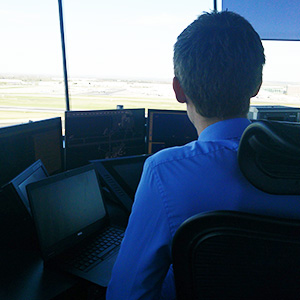
A dynamic solution
Through the variety of challenges faced by airports it is clear there is no ‘one answer fits all’ solution. Think have a large amount of experience working with a range of airports and have realised just how much of a challenge this can be! We understand that each airport has unique elements that affect the overall capacity and that these are pivotal in determining how to provide future improvements.
In fact, it has inspired us to develop tools that utilise flexible architecture – allowing us to respond dynamically to clients. This approach allows us to quickly generate models that specifically target the needs of the airport. We can quickly investigate a particular aspect of airport operations, e.g. the effect of variability on arrival landing times or whether there are any key dependencies arising from the current ground layout. The scope of the model is also tailored based on the available data. By aligning the model to the specific need of the airport allows for an effective use of time, which has the obvious advantage of minimising cost for our clients as well as making our models applicable to airports of any size.
Think have helped airports unlock additional runway capacity across a variety of different runway configurations and levels of traffic. A good example of this is a previous study Think conducted, modelling the peak throughput for various different wake separation schemes such as RECAT-EU. This had to factor in the local traffic mix, including the typical wake categories experienced each hour, as well as the local MET conditions. Importantly, a large amount of operational analysis was conducted to determine the typical spacing delivery accuracy that the airport was currently achieving. This performance could then be extrapolated in the model for each of the wake separation schemes.
Think also understand that the use of a tool requires the support of experienced analysts – firstly to develop a model that accurately captures operations at the airport and secondly to be able to correctly interpret the results. In addition, any model of the airport needs to be carefully validated against the specific circumstances being investigated.
Think Modelling Options
We have a variety of tools available, the selection of which depends on the complexity of the airport and the data that is available. Three options are typically offered, although these can be used in any combination. Examples of how each modelling option can be used are included below.
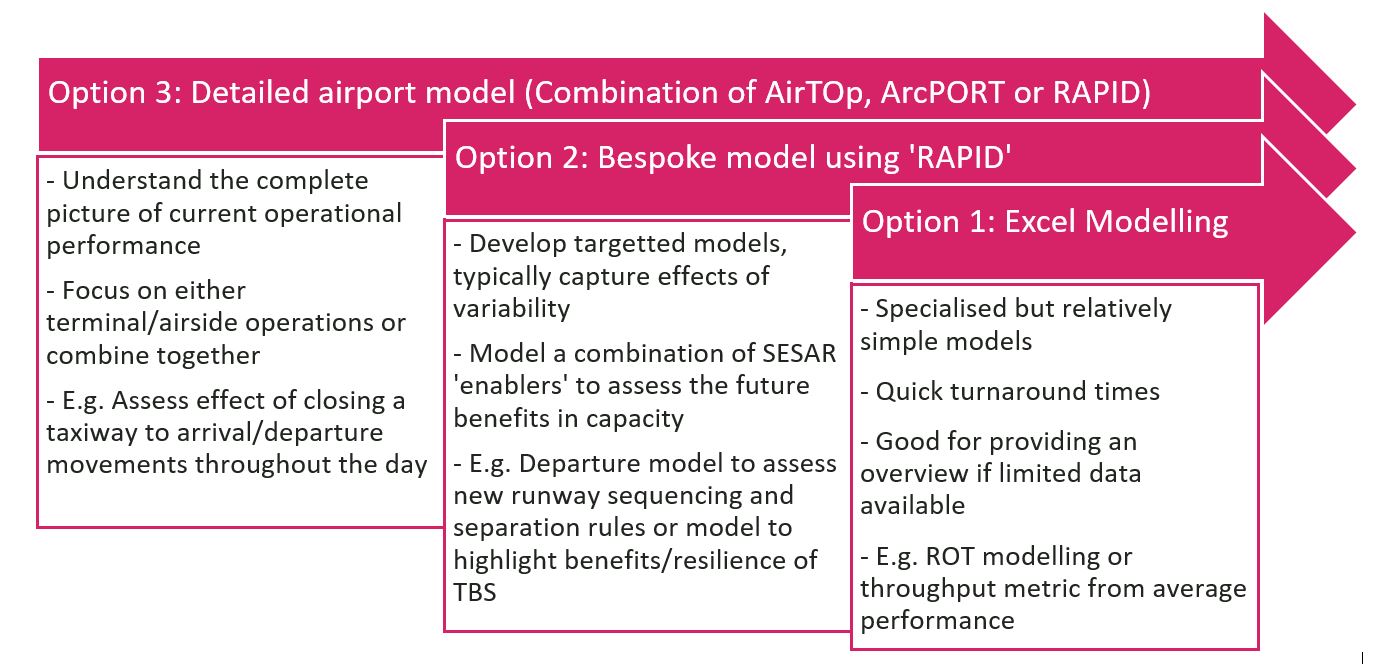
Example modelling options offered by Think, designed to model operational improvements for any airport and any level of complexity. Options can be used in any combination.
Specialised Excel models
Depending on the needs of the client, it might be more suitable to use a relatively simple but specialised model developed in Excel. It has the advantage that it is quick and easy to analyse commonly available airport data. Below are several examples of how Think have used Excel models:
- Assess the proportions of wake categories (and hence wake constraints) at the airport throughout the year
- Assess the Runway Occupancy Time performance
- Use of a Monte-Carlo model to investigate capacity based on an average performance of multiple traffic sequences (based on a daily schedule)
RAPID – bespoke modelling capability
RAPID has been developed by Think Research to provide a bespoke capacity assessment for airports and ANSPs. The tool can be used to understand current airport capacity, but the real advantage comes from being able to assess the capacity of future scenarios with various combinations of improvements applied to the airport. In a complex airport environment, improvement concepts (such as the SESAR enablers like TBS and RECAT-EU) can be very difficult to model using traditional Fast Time Simulation (FTS) software. Not only do these types of model require a significant overhead to setup, it can also be difficult to accurately capture vital aspects of the new concept – such as making use of a time-based system for aircraft separations. However, through using RAPID, we can quickly determine the most effective way to gain additional capacity, as well as gain a better understanding of the current operational constraints at the airport.
RAPID itself uses a data-centric approach, developed through integrating all our previous experience in capacity modelling and surveillance/met data analysis. This includes:
- A flexible approach to data preparation;
- A bespoke model specific to your airport;
- Automatic generation of performance metrics.
RAPID aims to build a picture of airport operations by comparing distributions of key metrics (such as Runway Occupancy Times) and grouping them under similar operational and environmental conditions (runway direction / weather). Increased detail can be added to the model by defining smaller subsets. For example, aircraft performance could be investigated for different Met conditions or different wake categories.
The core of RAPID consists of a discrete event model, which uses the input distributions, alongside a traffic schedule, to predict the capacity at an airport. A typical 24hr schedule can be assessed in seconds, which allows for multiple repeat runs – capturing the variability in capacity and gaining confidence in the results.
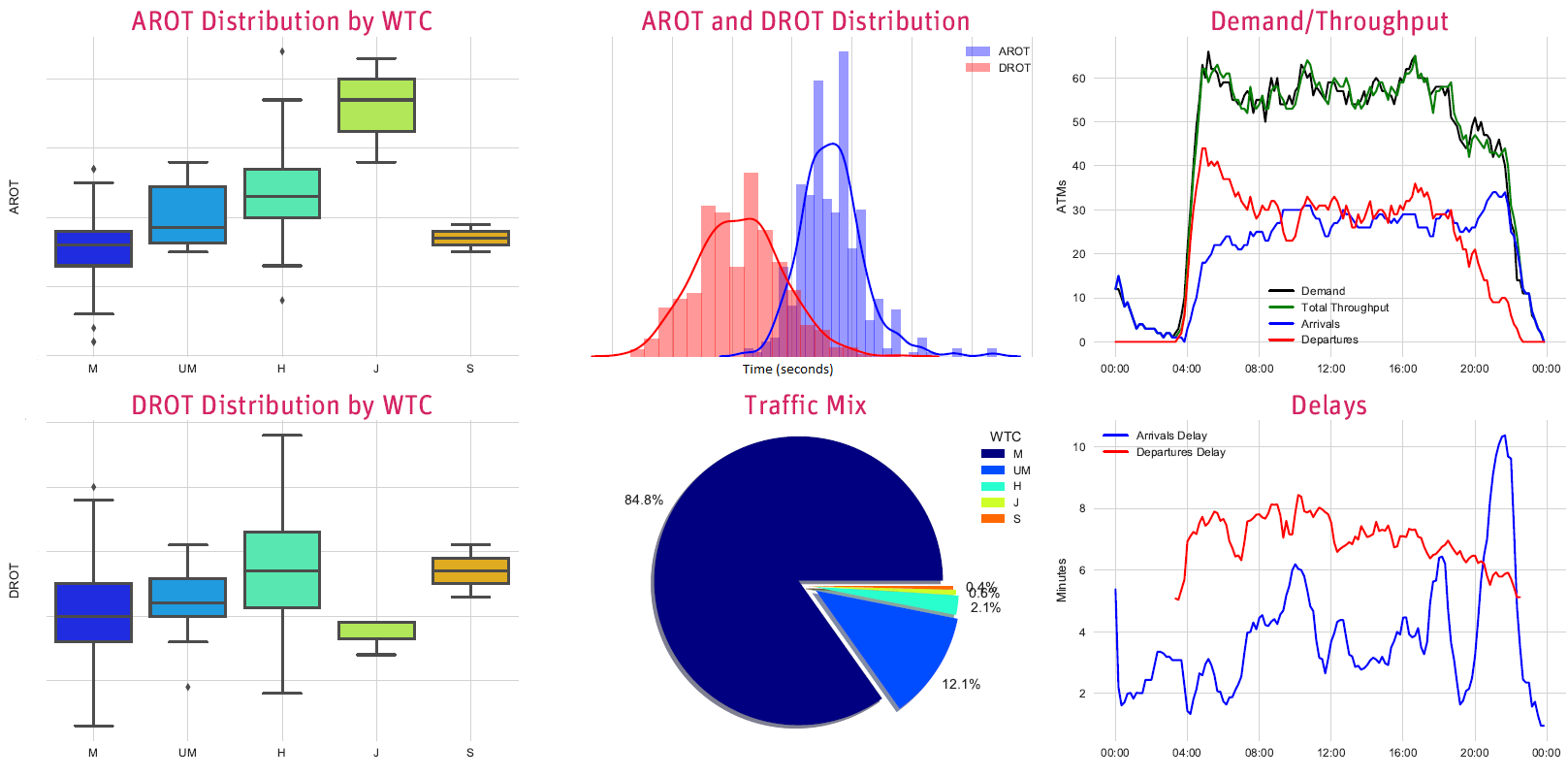
Example summary of input data from RAPID (left) as well as potential outputs to the model, seen here as daily throughput/delay metrics (right).
The functionality of RAPID is split across three main modules, as demonstrated below. The advantage of using three modules allows flexibility when assessing the capacity of an airport. It also means significantly less time is required to develop a bespoke model.
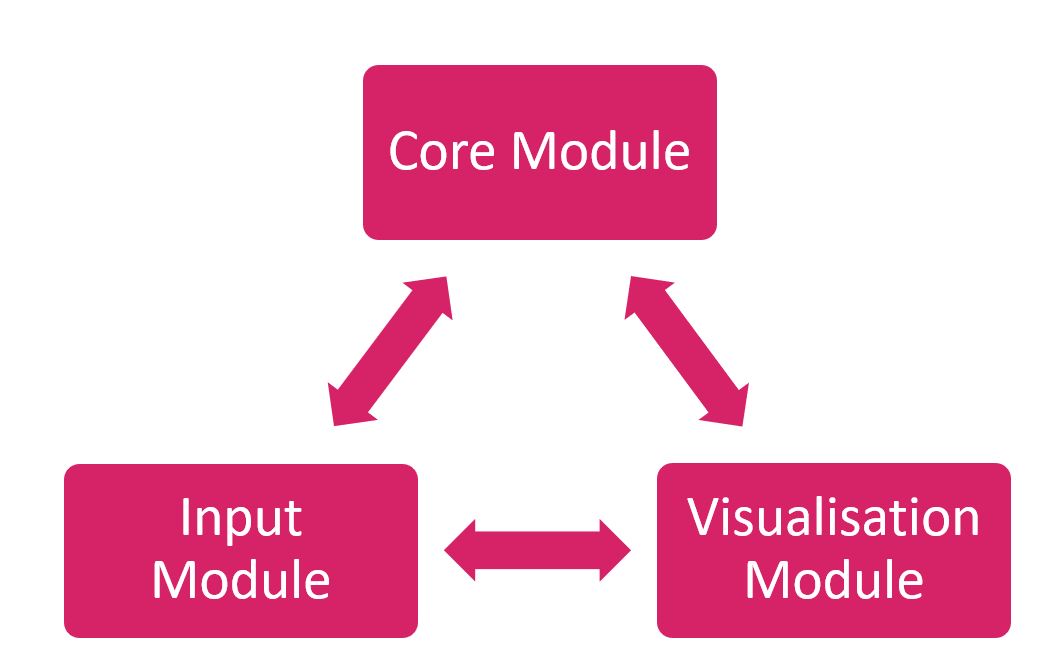
One of the key advantages of our bespoke ‘RAPID’ model is that it can be used to provide ‘what‑if’ analysis. This could include relatively simple scenarios involving different traffic mixes, through to understanding the true capacity benefits of upcoming SESAR enablers, such as TBS or RECAT, for a specific airport.
Detailed Fast time simulation capability
Sometimes a problem faced by an airport requires a model that contains a large amount of complexity to fully capture all the variable effects. An example of this could be if an airport wanted to assess the impact of closing a particular taxiway on the associated increase in delays to departure aircraft. For these types of problems, there is no need to re-invent the wheel, as several commercial products have already been designed to provide this type of solution. However, it is important to note that these tools only become fully effective when in the hands of experienced users. The increased complexity of commercial products requires specific knowledge to understand the model outputs and to make informed decisions on key operational parameters.
Another important part of understanding the capacity of an airport is to understand and assess the passenger flows in and around the terminal building. This can range from relatively simple analysis of understanding individual processes (such as security waiting times) through to developing a comprehensive terminal model using fast time simulation software such as ArcPORT / AirTOp.
Increasingly, we are also seeing our airport clients becoming more interested in understanding their environmental impact and trying to minimise noise emissions whilst maintaining capacity growth. Therefore, it is important that a capability in this area is obtained, specifically models that can help forecast the impact of emissions from future growth or airspace changes. Our consultants have worked with some of the world’s busiest airports on their noise management activities and are familiar with several commercial tools. We can support you in all elements of environmental assessment, management, policy and planning.
About Think
Think Research are specialists in providing airport, airspace and ATM capacity assessments at any level, understanding the unique requirements for regional airports through to large international airports. We are experts in using commercial FTS tools, such as AirTOp, ArcPORT and noise modelling (AEDT/IMPACT), as well as having the capability to develop our own bespoke models. If you are looking to understand your airport performance and the benefit of implementing new solutions make sure you speak to us first, we could provide advice that will save you a lot a money and avoid unnecessary overcomplication. Click here to contact a member of the team to find out more.

Author: Joe Irwin, ATM Consultant


Recent Comments